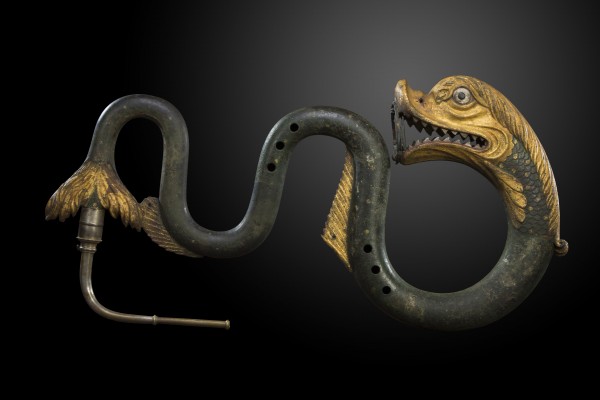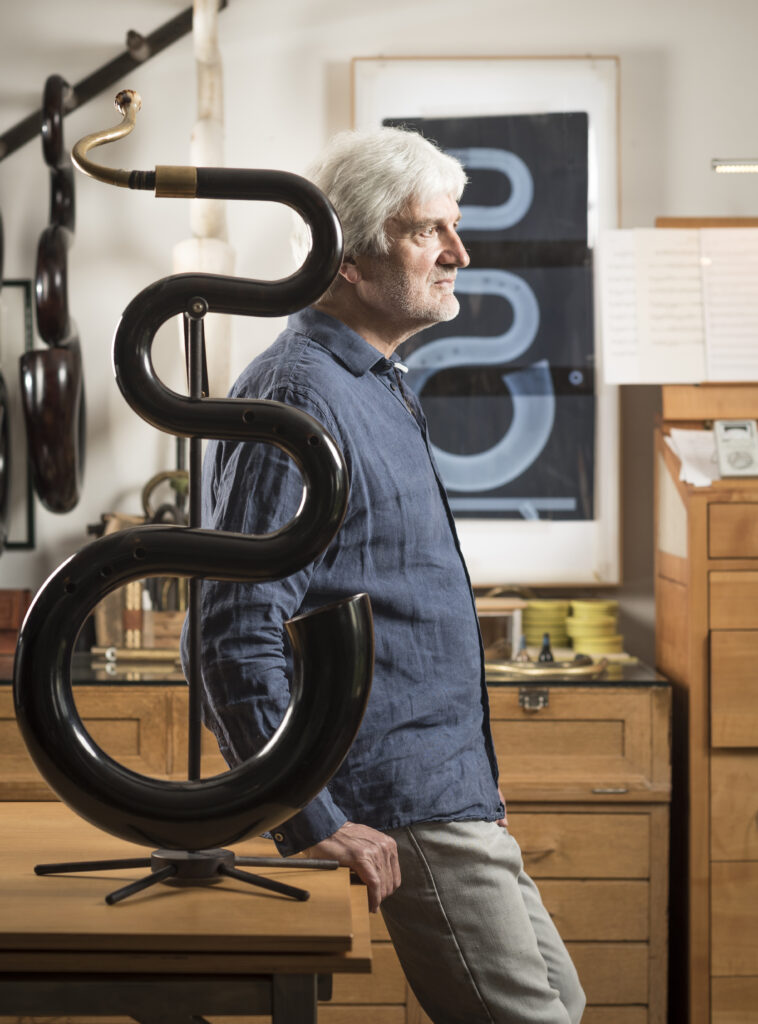
Serpent Villefranche de Rouerque 1800
Writing in the 1700s, the great music scholar Charles Burney remarked on a strange instrument he heard in French churches to strengthen the bass singers. It «keeps the voices up to their pitch», he wrote, «and so is a kind of crutch for them to lean on.»
It was the Serpent named after its characteristic shape, a double S with a brass bocal and a mouthpiece that gives it an uncanny resemblance to a snake. And it was hardly new at the time of Burney’s writing….
The Serpent is born – according to most scholars – in Auxerre, France. It was especially designed to support the plainchant in churches.
Despite its wooden body, which is wrapped in leather or parchment, the Serpent is actually classified as a brass instrument, in the same family as the cornetto or zink. It has six holes, which combined with the proper techniques, allows the performer to climb up and down three registers chromatically.
The Serpent is used in church music at the start. Its distinct bass tones, however, also find favor in instrumental ensembles and notably military music. A special reinforced version begins to appear on the battlefield as well.
Composers were fairly quick to adopt the serpent as an instrument for many different uses. It was not always appreciated, perhaps due to the very special texture of its voice. But the French mathematician and music theorist Marin Mersenne (1588-1648), who investigated sound frequencies from a scientific standpoint, admired the phenomenal acoustic and emotional range of the instrument: «To accompany as many as twenty of the most powerful singers and yet play the softest chamber music with the most delicate grace notes.»
The industrial age had a strong impact on the world of music by creating new and more effective instruments. The serpent with its «only» 6 holes soon found a rival in the ophicleide, a real brass instrument with up to twelve keys, which made it far more flexible. It was invented in 1819 by another Frenchman and is considered a predecessor to the tuba.
Nevertheless, the serpent continued to make its voice heard, but was increasingly considered an exotic instrument to be used only on special occasions.
The 20th century expanded the human understanding of music. From the Singstimme of Schoenberg, the Ondes Martenot, to the use of wind machines and synthesizers, musicians have explored all sorts of possibilities to extend the understanding of sound. Varese famously said that music was just «organized sound», and John Cage essentially said everything, even the random sound of city traffic, indeed even silence, was music.
By the same token, the late 20th century saw the movement towards authentic instruments and performance styles. So it’s no wonder that in a more liberal atmosphere, the serpent found a new niche.
The serpent’s rebirth began in the 1970s with the work of the late Christopher Monk (1921-1991), who worked tirelessly to revive ancient music and instruments like the cornett and the serpent. His London Serpent Trio gave the serpent an opportunity to make its voice heard again.
Among the men to popularize the serpent in recent times, is the French tuba virtuoso and jazzician, Michel Godard. He managed to connect what is termed ancient music to the freer harmonies of the world of jazz, and open the serpent to a wide range of musical possibilities.
It was the meeting between Michel Godard and inventor, leather craftsman and now serpent maker and performer Stephan Berger in the Jura Mountains of Switzerland that led to an extremely fruitful collaboration and a revolution of sorts in the 400+-year life of this remarkable instrument.
From the Bible to the Junglebook, one myth has always been attached to snakes: their ability to captivate, to hypnotize, to swallow whole, as it were.
The serpent – the instrument, that is – is no different. For Stephan Berger, coming in contact with the instrument was a game changer. A creative and craftsman, leather specialist and inventor, he lives with his wife Erna Suter in the Franches-Montagnes, a region of the Swiss Jura, area well-known amongst watch aficionados as a cradle of Swiss watchmaking.
In 2005, Serpent virtuoso and jazzman Michel Godard gave a concert Saignelégier, the main town in these hills. Michel Godard needed a leather covering for an instrument, and was soon steered to Stephan Berger’s workshop in Les Bois. The two men struck up a deep and productive friendship.
Stephan Berger approached his task with characteristic thoroughness and imagination. He analyzed the Serpent’s form, the materials it was made from. He experimented with various types of leather and parchment for the covering, and he browsed ancient manuscripts for details such as how to make the best glues.
It was an odyssey of sorts, a painstaking path shaped by fascination and challenges, and new discoveries. First he worked together with instrument-maker Matthias Wetter; together, they made a replica of a historical instrument from the collection of the Music Museum in Paris.
Stephan Berger even learnt to play the instrument, in order to deepen his knowledge of its subtleties. The serpent definitely had him in its grip.
His meetings with the late Rainer Weber, an expert instrument maker and restorer, allowed him to understand the serpent at a different level: “I had known the physical aspects, now I developed a profound insight and respect for the serpent,” says Stephan Berger.
This relationship went two ways as well. Having done his own in-depth research on the serpent, Stephan Berger started seriously improving on over 400 years of serpent-making. He designed new and better embouchures. His skill in leatherwork led him to cover and treat the surface of this remarkable musical tool in a more effective manner.
When music conservatories and musicians contacted him to ask if there was a way to build robust, affordable instruments for practice and for the road, Berger came up with a lightweight carbon-fiber serpent. Then, inspired by virtuoso Volny Hostiou, he succeeded in building another, smaller, F-tuned serpent that was based again on an instrument from the collection of the Music Museum in Paris.
In a bid to promote serpent-playing in the 21st century, Stephan Berger and Michel Godard created “The Serpent Journey,” a seminar and conference held every two years in Les Bois, Jura, Switzerland. Meanwhile, he continues to innovate. His latest creation is a state-of-the-art cleaning system that includes a dryer to help preserve the instrument (see video).
Stephan Berger was born in Läufelfingen, Switzerland (near Basel) in 1956. He trained as a smith and mechanic for agricultural machinery and began working in leather in 1980, together with his partner Erna Suter. The couple moved to the Franches-Montagnes (Free Mountains) in the canton of Jura, Switzerland, in 1987, where handcrafts, notably watchmaking, are a centuries-old tradition. Together, they began designing furniture, including chairs and tables. Stephan also developed a special clip for blind dog harnesses that is highly valued by the visually impaired in many countries around the world.
By Marton Radkai
